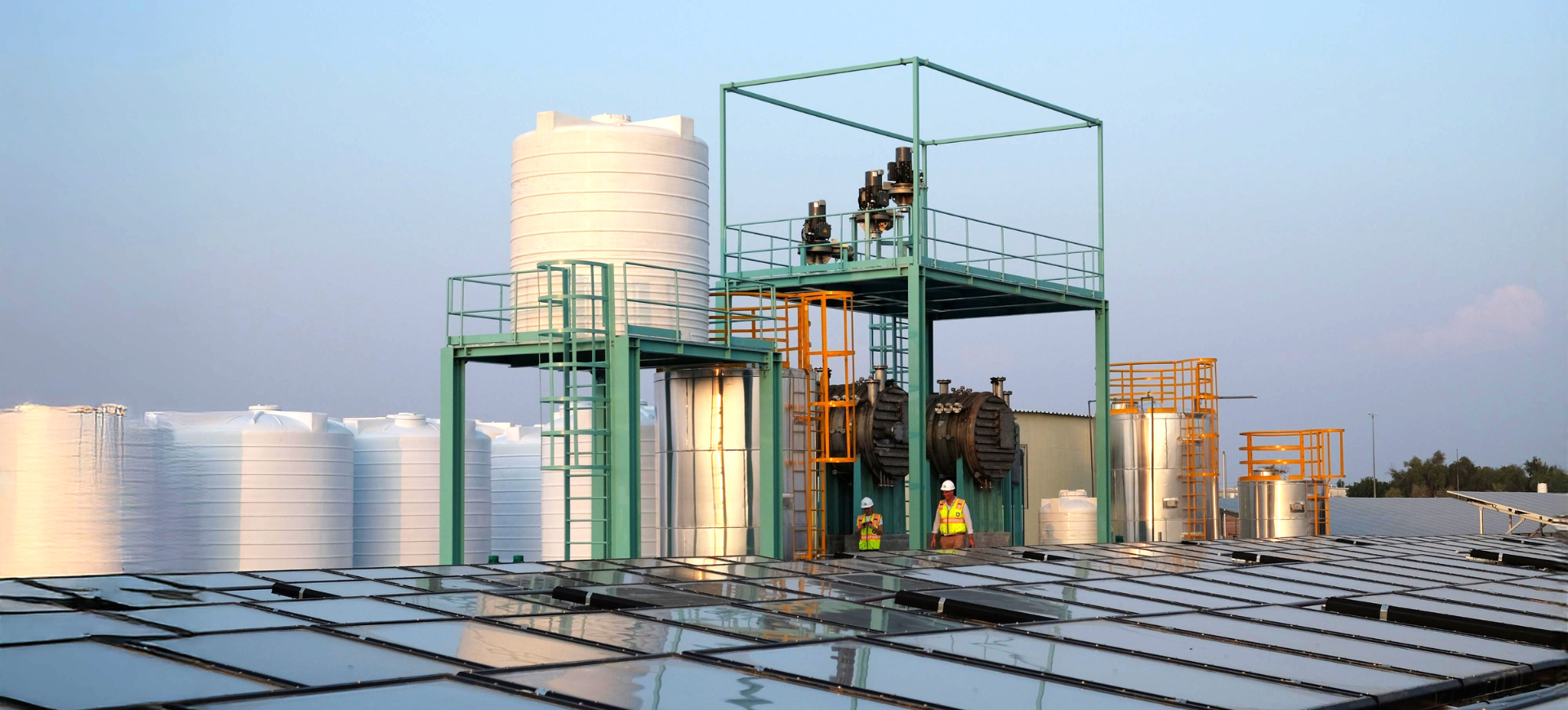Solving the Water-Energy-Food Nexus
How does the reliance on energy for water production—and vice versa—impact global efforts to combat climate change and achieve sustainability goals?
The energy and water sectors are deeply interrelated, as most water activity requires energy, and most energy activity requires water. Our quest to address global challenges, such as those categorised under SDGs 6 (clean water and sanitation for all), 7 (clean energy for all), and 13 (climate action), among others, requires a system-thinking approach departing from the water-energy nexus, without tackling water and energy separately. We must prioritize low-carbon and efficient technologies that address both water and energy demands.
Water and wastewater activities account for ~4% of global electricity consumption, and that figure is expected to double by 2040 (Mortenson Center in Global Engineering, 2024). Water management more broadly is responsible for around 10% of global greenhouse gas emissions (ibid.). This is mainly related to energy use for water treatment and transport, as well as emissions from wastewater decomposition, decomposition of organics in reservoirs, and destruction of wetlands.
As natural freshwater resources are increasingly depleted, polluted, and impacted by climate change, this will likely lead to a greater reliance on energy-intensive sources of water supply such as desalination. In the Middle East, desalination’s share of total final energy consumption is expected to increase from 5% today to almost 15% by 2040 (IEA, 2020). Global energy demand for desalination has already nearly doubled since 2010, and current trends point to another doubling to 2030 (IEA, 2024). It is estimated that global GHG emissions from desalination will increase from around 76 megatonnes of CO2e today, to 218 megatonnes by 2040 (Jones et al., 2019).
Conversely, energy generation often depends on vast quantities of water, especially for power plants and energy is required to drive all other processes. Energy is prosperity and water is essential for almost every aspect of producing energy, from electricity generation to fossil fuel extraction to biofuels cultivation. The energy sector accounts for roughly 10% of total global freshwater use (IEA, 2023). As we shift towards renewable technologies like solar and wind, the energy system’s dependence on water will also decrease.
What are the most critical challenges in balancing the interdependence between water and energy systems, particularly as climate change intensifies?
As producing clean water often requires significant energy, and energy production relies on water-intensive processes, this feeds a feedback loop that intensifies resource scarcity and environmental degradation. Some key challenges in balancing this interdependence include:
Climate change: Climate change complicates the water-energy nexus by altering both the energy and water systems, for example by exacerbating water scarcity through droughts, or by increasing energy demand for cooling due to increasing temperatures. Striking a balance requires innovative solutions that decouple water and energy systems from fossil fuel dependence, as well as focusing on technologies that are resilient to emerging climate shocks.
AI boom: It is now well known that data centers consume 1-2% of global electricity and is expected to grow 160% by 2030 to power the AI boom (Goldman Sachs, 2024). However, less known is how data centers also consume water, either directly for cooling, or indirectly through the water requirements of non-renewable electricity generation. For example, around one-fifth of the direct water footprint of US data centers comes from moderately to highly water stressed watersheds, while nearly half are powered by power plants located in water stressed regions (Asthine and Mytton, 2024). This brings to light the importance of efficient data centers, both in terms of energy use as well as water use.
Water-energy-food nexus: As 70% of global water withdrawals are from the agricultural sector, it is essential to look at the broader energy-water-food nexus. With a growing global population and rapid urbanization, water demand for irrigation and food production will grow, potentially introducing resource competition and tension between different water using sectors. This is particularly acute in regions where water security and food security are national priorities, such as in the Middle East. In the UAE for example, 85% of all food is imported, and freshwater withdrawals exceed renewable freshwater resources by 160x (AGSIW, 2024). Water-energy solutions therefore need to strike a balance between broader social and human priorities, such as food security.
These three converging megatrends of climate-induced water scarcity, fast-growing AI datacenters, and food systems stress can be jointly addressed through resilient, efficient and sustainable technologies to produce both water and energy.
From a technological perspective, what advancements are needed to decarbonise water systems and make them more energy-efficient?
The decarbonization of water systems requires:
-Integration of renewable energy into desalination and water treatment processes.
-Development of closed-loop systems (e.g. Minimal or Zero Liquid Discharge) that reduce waste and energy consumption.
-Adoption of digital technologies, such as AI and IoT, to optimize water production and distribution in real-time.
-Investment in modular, decentralized systems that bring water solutions closer to the point of use, reducing energy-intensive distribution networks.
What role do renewable energy sources play in addressing the water-energy nexus, and how can they be integrated into water production and treatment systems?
Some low-carbon forms of energy, such as solar and wind, require much less water, and therefore an accelerated energy transition will also reduce the energy sector’s water dependence. Renewable energy sources like solar, wind, and geothermal are key to breaking dependence on fossil fuels for water production. For example, solar-powered desalination, such as the technology developed by Desolenator, is a game-changer. By leveraging renewable energy, we can address water scarcity while minimizing carbon emissions. Integration can be achieved through hybrid systems that combine renewable energy with energy storage for 24/7 operation. The renewable energy systems can even feed electricity back into the grid in times of excess consumption. Another option that
Desolenator is bullish on is retrofitting existing industrial facilities to utilize waste heat, therefore avoiding an increase in energy demand.
However, it is also important to note that solar and wind are intermittent sources of energy. Hence, we will need energy storage and/or water treatment systems that can handle the variability of renewables to address the challenges in the energy-water nexus. Moreover, some low-carbon alternatives, such as biofuels, carbon capture, utilization and storage (CCUS), or nuclear power are also relatively water-intensive (IEA, 2020), so we must always consider the suitability of different energy sources for certain water applications. Moreover, as energy processes generate waste heat, we should learn to integrate waste heat in water treatment and desalination processes to make the overall systems more efficient.
Many vulnerable regions face a dual crisis of water scarcity and energy poverty. What scalable solutions do you envisage that might address these intertwined challenges?
Decentralized, off-grid solutions hold immense promise for addressing this dual crisis. Technologies like solar-powered desalination and purification systems can provide clean water and energy to remote areas without reliance on extensive infrastructure. Community-based water-energy hubs that integrate renewable energy production with water treatment can create localized, scalable solutions. Additionally, investment in capacity-building and training ensures communities can sustain these systems independently.
How can policymakers and industries collaborate to create frameworks that accelerate the decarbonisation of water systems?
Policymakers and industries can collaborate effectively by focusing on several key areas to accelerate the decarbonisation of water systems. First, they must set ambitious decarbonisation and water reuse targets specifically tailored for industrial water users, creating a clear roadmap for sustainable water management. Incentive structures and market-supporting mechanisms are essential to encourage industries to adopt low-carbon technologies, making these innovations more accessible and financially viable.
Promoting public-private partnerships is another critical aspect of collaboration. By pooling resources and expertise, these partnerships can drive the funding and implementation of innovative solutions that might otherwise be out of reach. Additionally, establishing robust regulatory frameworks is vital to ensure renewable energy integration in water production processes, enabling a transition to greener energy sources and further reducing emissions.
Through these combined efforts, policymakers and industries can create a cohesive framework that accelerates the transformation of water systems towards sustainability and resilience.
In your view, what are the most promising innovations or approaches emerging globally to address the water-energy nexus?
Globally, several promising innovations and approaches are emerging to address the complex water-energy nexus. Solar thermal desalination systems stand out by combining renewable energy with advanced design to enhance efficiency and sustainability. Expanding water treatment capacity at both existing plants and new builds is another critical area, with innovative integrations such as waste heat utilization playing a key role. Exploring alternative energy sources like geothermal energy offers untapped potential for water processing.
Circular water systems are gaining traction, focusing on recycling wastewater, recovering energy, and minimizing waste through technologies like Zero Liquid Discharge. AI-driven optimization tools are also transforming the field by reducing inefficiencies in both water and energy systems, ensuring smarter resource management.
Energy-positive water treatment plants, which generate more energy than they consume, represent a breakthrough in sustainable water management. Decentralized modular solutions further complement these efforts by adapting to local conditions and reducing reliance on centralized infrastructure. These innovations collectively pave the way for a more integrated and sustainable approach to managing the water-energy nexus.
What steps should global initiatives and summits like the World Future Energy Summit take to prioritise and act on the water-energy issue in coming years?
Global initiatives and summits like the World Future Energy Summit should take decisive steps to prioritise the water-energy nexus as a critical focus area in the coming years. Highlighting the interconnected challenges of water and energy as a central theme can elevate its importance on the global agenda. These platforms should actively facilitate knowledge exchange by bringing together stakeholders from the water, energy, and climate sectors, fostering collaboration and the sharing of innovative ideas.
Promoting sustainable water-energy solutions requires innovative financing mechanisms, and summits can play a role in showcasing and advocating for these models. Encouraging the adoption of renewable-powered water technologies is also essential, and this can be achieved through collaborative efforts and pilot projects that demonstrate the feasibility and impact of such solutions.
Finally, aligning policies to integrate water-energy considerations into national and international climate goals is crucial. By advocating for this integration, summits can help shape a coordinated approach to tackling the water-energy nexus on a global scale.












